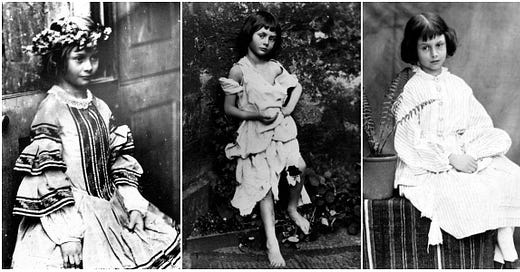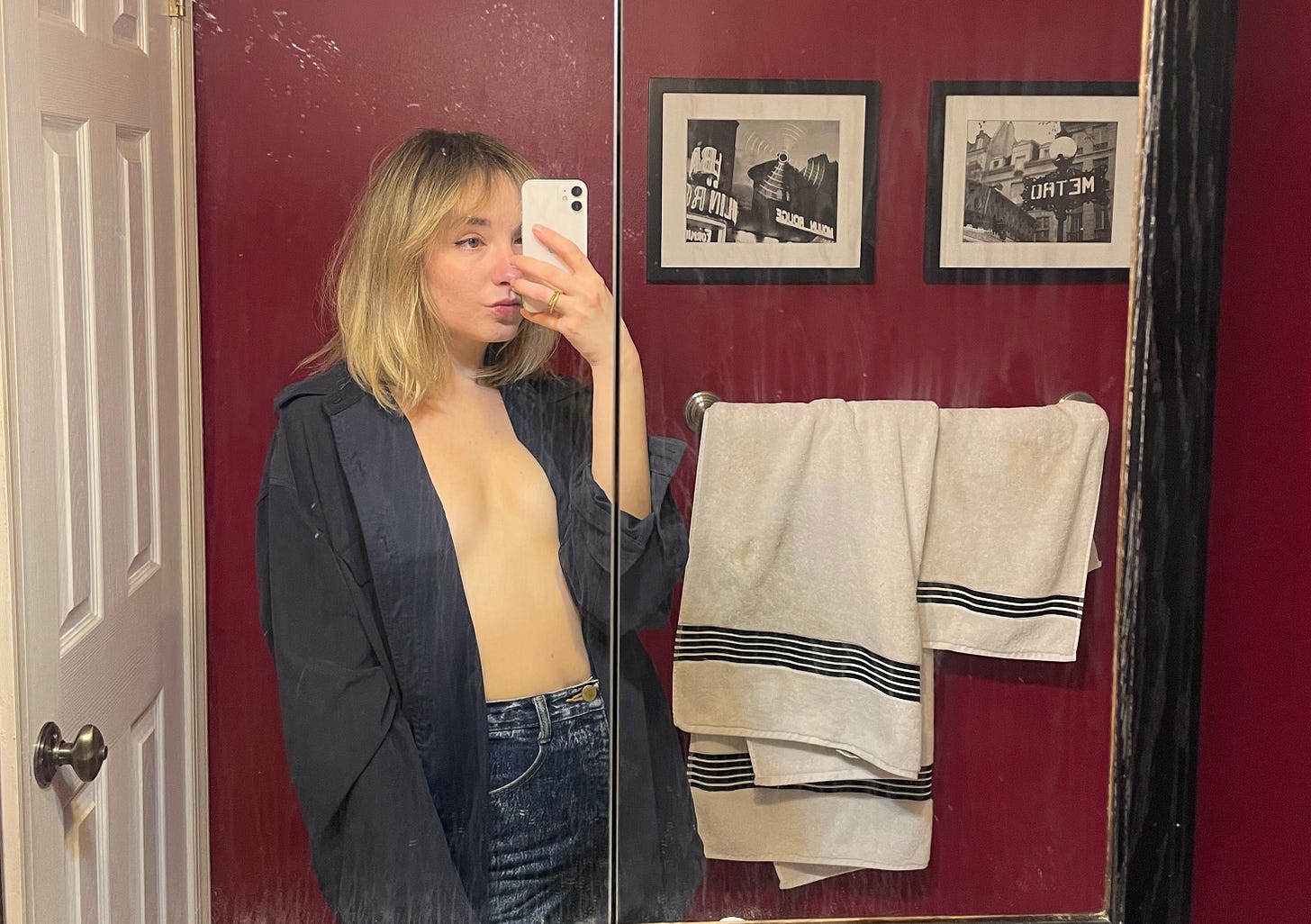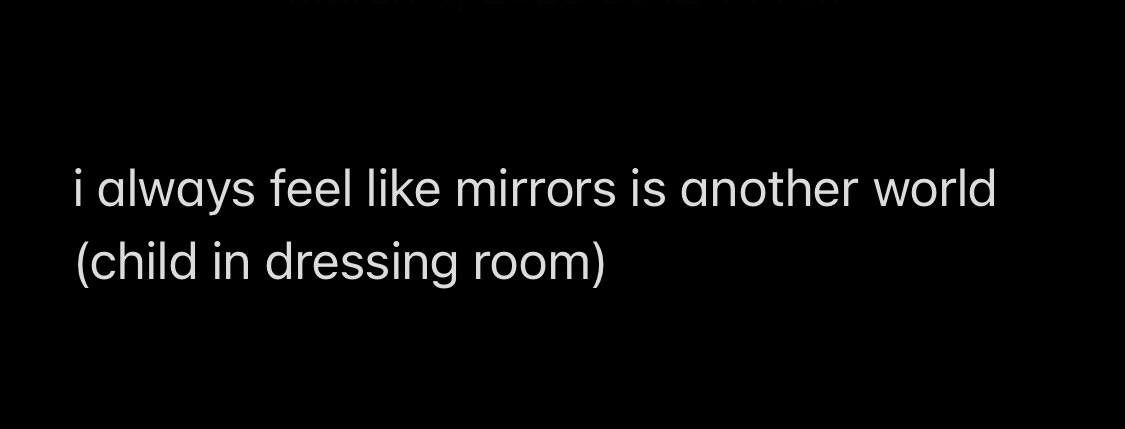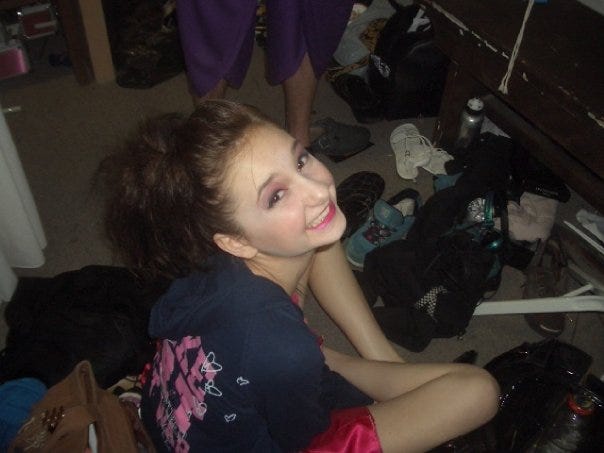through the looking glass
this is not the essay i thought i was writing, let me say that much right now.
There is a magic mirror in my childhood bathroom.
Not the kind that spouts riddles or transports curious girl children to topsy turvy worlds; the tri-fold medicine cabinet kind with a cheap plywood frame. The frame is painted gloss black, the walls around and behind it a deep, somewhat oxidized red. Neither have been repainted in some time. It has three lightbulbs (one above each panel) and I don’t think they’re all of the same kind or wattage though I’m sure at some point they were. Behind the fold out panels reside ancient beauty products in early 2000s packaging: St. Ives vanilla body lotion, something from that brand “philosophy”, coagulated sunscreens that never made it to the community pool.
The bathroom is hardly used — my father lives alone with his own ensuite and I have not lived in this house in any meaningful way since I was 11 — and so the mirror is rarely if ever cleaned. Sometimes when I visit there is a smell of cleaning fluid (citrusy, artificial) but generally there is a layer of dust and grime upon surfaces and years-worth of toothpaste spatter, however infrequent, remain: a scrim.
I do not like visiting this house. It is haunted, as most childhood homes are, and it has powers of its own. Stepping through the front door transports this charming girl-woman into the sullen, monosyllabic adolescent that never lived there. My jaw is tense, my eyes go dead, I bristle at the slightest inquiry into my life. Mirror mirror on the wall, who’s the grouchiest of them all? Me, by more than a mile.
The mirror is magic because it is invariably flattering, and I exploit its properties for all they’re worth. Looking through my camera roll I can quickly tell when I’ve landed on a visit to the house in Virginia by the swaths of deep, somewhat oxidized red squares. They occur in groups of 3-5 per outfit, punctuated by photos of works in the National Gallery or my dad’s African Grey parrot or meals eaten on a deck.
I look good in these photos. Fresh faced or made up, dead eyed or slyly smiling, I’m alluring. When, on my most recent trip, I post one to my instagram story, it gets hearts from cool girls and friends’ boyfriends, replies from potential lovers (“hot”, “long hair”). My best friend says I’ve never looked better. My ex replies asking about our cat (less than a year ago more than one of these photos appeared in the carousel of my image he used as his phone background). Validation: my favourite drug.
There was a tweet I saw semi-recently, one of those bits of regurgitated insight on the modern experience that is not all that insightful but continues to do numbers. I’m not going to go to the trouble to find it, but it went something like: remember that the more beautiful a girl’s instagram stories are, the more depressed she is.
When I lived in Virginia for a few weeks at a time this summer, I would take videos of myself eating farmer’s market peaches or strip mall strawberry ice cream on the miles long walks I would take to avoid the house and its ghosts. I would plate the food my father and I fought about beautifully and shoot it from above amongst the mid atlantic greenery, next to the books I clung to as shields from conversation. When my father went out, I’d shoot onlyfans content on the deck and repurpose the tamer moments for instagram (once accidentally posting an uncut video to the grid for over an hour before noticing). And yes, I’d stand in front the somewhat oxidized red wall and point my phone camera at the toothpaste scrimmed glass over and over. A ritual. A routine.
Most of this content never gets shared. I am too aware of what the repetitions reveal and too afraid of seeming cringe and so my camera roll is filled with 15 second videos and slight variations on the same image. Still, when I visit my childhood home and my one surviving parent, this is what I do. These are the memories I make. The more beautiful a girl's instagram stories...

My first memory takes place in front of a bathroom mirror two childhood homes before this one. In it, I am held by my mother, balanced on a hip. She points to our reflections. I point to an old tabby: “Kitty cat.” My first words.
There is no possible way that this is a real memory. I began speaking significantly before my first birthday (brag) and early childhood memories begin at an average of 2 and a half. I have no other recollection of this cat, though I know her name to be Celia (my childhood cat, Emma the Cat Lump, came later). I don’t remember the layout of this bathroom or the color of the walls. All I have is the sequence of pointing, identifying, and speaking as my mother did the same with our reflections. “Look, that’s you!” “Kitty cat.”
Can I see myself in the mirror of this memory? Or have I simply been a good actor and essayist, memorizing the story of recognition and speech into a stable foundation for the house of my personal narrative? The words have been verified but the image is mine alone: that house in Dundas, Ontario was sold almost 25 years ago, my mother is no longer alive, and my father wouldn’t know (or so I tell myself to avoid asking). The upkeep of my personal memory palace falls on me. I am both object and author, sad girl and storyteller: I make it beautiful.
Did you know that Alice Through the Looking Glass begins with a precocious girl-child speaking to a pair of kittens? You probably did, the book is famous and constantly adapted, but I didn’t until I decided to title this piece after it and thought it might be a good idea to check it out. I didn’t read the book in full (yawn) but I did spend a lot of time looking at photos of Alice Liddell.
Legend has it, Charles Dodgson (Lewis Carroll) came up with the story of Alice’s Adventures in Wonderland while out boating with the Liddell sisters, spitballing something silly to charm the children. Upon hearing her name applied to a character in a story, 10 year old Alice Liddell insisted he write it down. She was given the first manuscript in 1864, which she sold in 1928 to pay debts accrued after the deaths of her husband and sons. In the intervening years, she grew up, stopped speaking to Dodgson, hiked an active Mt. Vesuvius with her sisters, started modeling for Julia Margaret Cameron, got married, became a mother, became a widow, became old.
By the time of the legendary boat ride, Alice had been modeling for Dodgson for at least 3 years, since she was 6 or 7. Dodgson’s photographs famously feature nude children, which was not odd for the time (Julia Margaret Cameron also photographed children in varying states of undress), and were often taken at the behest of the children’s parents. I’m not about to go down the “was Lewis Carroll a pedophile?” rabbit hole that her image usually opens up, though from the little research I did into his letters it seems like he wasn’t all that different from contemporary straight male artists: horny for younger women, keen on bucking convention, bit of a cad. His gaze is far less interesting to me than hers is looking back.
Looking at the photos Dodgson took of Alice, I am struck not by the exposed shoulder or cocked hip but by the look on her face. In these photos, taken between the ages of 6 and 10, and in those taken by Julia Margaret Cameron a decade later, she stares the camera down with an eyebrow almost imperceptibly raised, in a look that is both confrontation and seduction. It is the look of someone comfortable as an object of admiration, a willing dress up doll who will return to her position in front of the camera again and again. It is the look of someone in control of her narrative, aware of her role. It is a look one might call “knowing”. It is a look I know well.
I am obsessed with looking at myself. The obsession is not one of vanity, not entirely, though I am vain, incredibly so. I’m vain to the point of picking fights with directors about costume choices, rarely leaving the house without makeup, and having a face that snaps to a pout every time I’m in front of a reflective surface or camera which my mother used to call my “ballet face”. This makes me sound like an aging old Hollywood actress, but I’ve been this way since I was a child: posing, performing, precocious.
What do children know? When I adopted that face as a footed-tight clad baby ballerina, did I know I was applying a mask of innocent surprise that would be perceived as charming? Did I do it intentionally, out of vanity? Can children be vain?
This week I ran into a woman who was the costume designer for the youth theatre I called home from age 13-16. She had always had a fondness for me, she tailored my grade 8 grad dress, she and my mother were close. She introduced me to the friend she was with and we chatted, reminisced. I mentioned that I had found the tiny feathered corset and ruffled jumpsuit she made me for a production of Rocky Horror when I was 14 in a closet in the house in Virginia — “Wow, it really was a different time,” she says, her face the yikes-emoji. I copy her expression. We laugh.
I’d run into her before. She lives in the neighborhood of my work and stops in from time to time. The first time we saw each other we cried, the memory of my mom filling us both. We threw names around of the people we had known over a decade earlier, a certain man’s name came up. “He turned out to be a real creep, didn’t he?” I don’t know what my face did at that moment.
There’s a lot that can be said about the history of sexualizing bodies before they are fully developed. There’s a lot I can and have said about my relationship with my former youth theatre director when I was 17 and he was 32. There’s a lot that can be said about control of one’s image and control of one’s narrative and the overlap between the two. The overlap of all of the above.
In 1863, there was a rift between Dodgson and the Liddell family, and while he rekindled his relationship with Alice’s parents (and gave her the manuscript) in 1864, he never took her or her sisters out again. In an interview some years later, Alice’s older sister Ina suggested that Dodgson had become “too fond” of Alice and the fissure occurred when he asked her parents for then 11-year-old Alice’s hand in marriage, though Alice was ill the day of the interview and has never corroborated her sister’s story. Some say Ina was the one Dodgson was after, so I suppose we’ll never know.
“He turned out to be a real creep, didn’t he?”
I said earlier I wasn’t interested in the pedophile question in relation to Lewis Carroll and Alice Liddell, that her gaze was much more interesting to me than his. The way she stares the camera down. The way she returns, years later. A ritual. A routine.
When I started this essay I had no intention of writing about Alice Liddell. When I started writing about her I had no intention of writing about her sexualization or her relationship with Dodgson. I deflected, said he was like any other straight male artist horny for younger women, “bit of a cad”. I actually wrote and deleted the line, “this is not an essay about how early sexualization objectifies a young woman’s sense of self and leaves her chasing her own image into adulthood.” I thought I was writing about my own vanity and self mythologizing, and yet….
There’s a photograph that hangs on a wall in the house in Virginia where I look just like a young Alice Liddell. I have her brunette bob and flower crown. I smirk at the camera. I’m somewhere between 4 and 6. The photo was taken at the behest of my parents, a portrait session that also included a straw hat.
In the intervening years between that portrait session and my recent trip to Virginia I attended a prestigious ballet school, became literally and emotionally distant from my father, began acting, was groped on stage at 14 in Rocky Horror, lost my virginity to a man 15 years my senior, lived in at least 6 cities, was in a nearly 6 year long age appropriate relationship, began writing plays, became motherless, became an online pornographer, became single, became a woman.
As I’m writing this on the balcony of my latest sublet, getting pleasantly sunburnt in early April, I think about texting my dad to ask him to take a photo of my childhood portrait for me to use in this piece. I hesitate: doing so would mean acknowledging that my father and my writing exist in the same narrative, which is something I cannot do, and I’m actually not sure the photo exists. It may only hang on the wall of the memory palace of my childhood, down the hall from the bathroom mirror and my mother’s reflection and Celia the cat.
When Alice Liddell grew up, she sat in front of Julia Margaret Cameron and posed as graces and saints. When I visit my childhood home in Virginia, I stand in front of a toothpaste scrimmed mirror and pose as happy and beautiful.
This is an essay about childhood and memory and narrative. This is an essay about vanity. This is an essay about how early sexualization objectifies a young woman’s sense of self and leaves her chasing her own image into adulthood.
I do not text my father. I post a provocative selfie to my instagram. I tell my own story.










